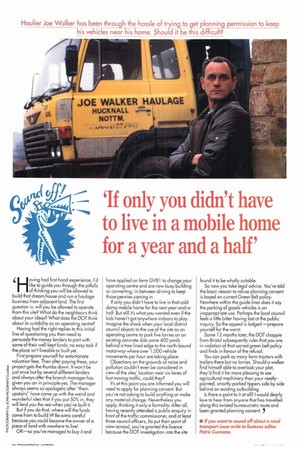'If only you didn't have to live in a mobile home
Page 48

If you've noticed an error in this article please click here to report it so we can fix it.
for a year and a half'
i aving had first hand experience, I'd like to guide you through the pitfalls of thinking you will be allowed to build that dream house and run a haulage business from adjacent land. The first question is: will you be allowed to operate from this site? What do the neighbours think about your ideas? What does the DOT think about its suitability as an operating centre? Having had the right replies to this initial line of questioning you then need to persuade the money lenders to part with some of their well-kept funds; no easy task if the place isn't liveable or built yet. First prepare yourself for extortionate valuation fees. Then after paying these, your project gets the thumbs down. It won't be just once but by several different lenders and always after the branch manager has given you an in principle yes. The manager always seems so apologetic after "them upstairs" have come up with the weird and wonderful idea that if you put 50% in, they will lend you the rest when you've built it. But if you do that, where will the funds come from to build it? Be extra careful because you could become the owner of a piece of land with nowhere to live!
OK—so you've managed to buy it and have applied on form GV81 to change your operating centre and are now busy building or converting; in between driving to keep those pennies coming in.
If only you didn't have to live in that cold damp mobile home for the next year-and-ahalf. But still it's what you wanted even if the kids haven't got anywhere indoors to play. Imagine the shock when your local district council objects to the use of the site as an operating centre to park five lorries on an existing concrete slab some 400 yards behind -a tree-lined edge to the north-bound motorway where over 1,000 vehicle movements per hour are taking place.
Objections on the grounds of noise and pollution couldn't even be considered in view of the sites' location near six lanes of Fast moving traffic, could they? It's at this point you are informed you will need to apply for planning consent. But you're not asking to build anything or make any material change. Nevertheless you apply, thinking it only a formality. After all, having recently attended a public enquiry in front of the traffic commissioner, and at least three council officers, (to put their point of view across), you're granted the licence because the DOT investigation into the site found it to be wholly suitable. So now you take legal advice. You're told the basic reason to refuse planning consent is based on current Green Belt policy. Nowhere within the guide lines does it say the parking of goods vehicles is an inappropriate use. Perhaps the local council feels a little bitter having lost at the public inquiry. So the appeal is lodged —prepare yourself for the worst. Some 12 months later, the DOT chappie From Bristol subsequently rules that you are in violation of that sacred green belt policy and finds in favour of the refusal.
You can park as many farm tractors with trailers there but no lorries. Should a walker find himself able to overlook your plot, they'd find it far more pleasing to see agricultural machinery than your neatlypainted, smartly parked tippers side by side behind an existing outbuilding. Is there a point to it at all? I would dearly love to hear From anyone that has travelled along this twisted bureaucratic route and been granted planning consent.
















































































































